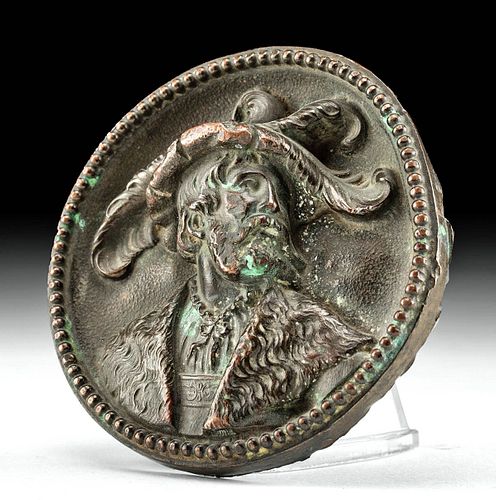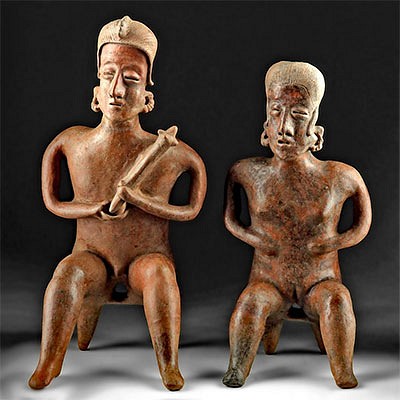16th C. European Copper Roundel with Relief Portrait
Lot 218d
About Seller
Artemis Fine Arts
686 S Taylor Ave, Ste 106
Louisville, CO 80027
United States
Selling antiquities, ancient and ethnographic art online since 1993, Artemis Gallery specializes in Classical Antiquities (Egyptian, Greek, Roman, Near Eastern), Asian, Pre-Columbian, African / Tribal / Oceanographic art. Our extensive inventory includes pottery, stone, metal, wood, glass and textil...Read more
Estimate:
$1,200 - $1,800
Absentee vs Live bid
Two ways to bid:
- Leave a max absentee bid and the platform will bid on your behalf up to your maximum bid during the live auction.
- Bid live during the auction and your bids will be submitted real-time to the auctioneer.
Bid Increments
| Price | Bid Increment |
|---|---|
| $0 | $25 |
| $300 | $50 |
| $1,000 | $100 |
| $2,000 | $250 |
| $5,000 | $500 |
| $10,000 | $1,000 |
| $20,000 | $2,500 |
| $50,000 | $5,000 |
| $100,000 | $10,000 |
| $200,000 | $20,000 |
About Auction
By Artemis Fine Arts
Mar 25, 2021
Set Reminder
2021-03-25 10:00:00
2021-03-25 10:00:00
America/New_York
Bidsquare
Bidsquare : CLEARANCE Antiquities | Ethnographic Art
https://www.bidsquare.com/auctions/artemis-gallery/clearance-antiquities-ethnographic-art-6663
Featuring discounted pricing on Asian art, Classical antiquities from Egypt, Greece, Italy, and the Near East...plus Pre-Columbian, Tribal, Russian Icons, Spanish Colonial, Fine Art, more! Artemis Fine Arts info@artemisfinearts.com
Featuring discounted pricing on Asian art, Classical antiquities from Egypt, Greece, Italy, and the Near East...plus Pre-Columbian, Tribal, Russian Icons, Spanish Colonial, Fine Art, more! Artemis Fine Arts info@artemisfinearts.com
- Lot Description
**Originally Listed At $600**
Western Europe, Renaissance, ca. first half of the 16th century. A beautifully cast copper alloy roundel featuring the bust of a lavishly dressed man facing to his left in high relief, formed using the lost wax (cire perdue) method. Encircled by a lovely border of raised dots, the figure wears a beret with four large swirling feathers, possibly ostrich plumes, extending to both sides as a fur lined overgown drapes over his shoulders and opens at the front to expose a linen shirt with a small ruff created by a drawstring tied in a bow and the top of a doublet decorated with a phytomorphic motif. Locks of wavy hair, a beard, and moustache frame his deep-set eyes and sharp nose. A gorgeous example of portraiture from one of the most prominent periods for self-fashioning! Size: 2.875" diameter (7.3 cm)
Invented by Pisanello (1395 to 1455), commemorative portrait medals were of great popularity in the Renaissance and were commonly commissioned by the noble class. Their success is due to several reasons; the humanist emphasis on the individual, the renewal of interest in classical antiquity and the medal's likeness to a Roman coin, and a desire to establish present power and future progeny. The sixteenth century's understanding of portraiture and its place in history is perhaps best demonstrated in a quote from Michelangelo, who when criticized that his portraits looked nothing like the men they were supposed to represent replied, "In a thousand years nobody will be able to say what they had looked like, but they will nevertheless continue to honor these men as I have represented them." Commemorative portrait medals were such a popular form of portraiture that they were often documented in other mediums of visual representation, such as painting (see "Portrait of a Youth with a Medal," Sandro Botticelli, 1475) and printmaking. The latter's most famous example is Giorgio Vasari's "Le vite de' piu eccellenti pittori, scultori e architettori (Lives of the Most Eminent Painters, Sculptors, and Architects)" from 1545 and 1560, in which each artist is portrayed in a tondo as a portrait medal at the start of each chapter.
Note how the elaborate detail put into the figure's dress, remarkably different from the attention given to the attire of an emperor on a Roman coin, demonstrates the Renaissance interest in fashion as part of conspicuous consumerism. The period was so greatly fascinated with the role of clothing in self fashioning that German accountant Matthaus Schwarz famously published "Trachtenbuch" or "Book of Clothes" in which he commissioned an artist to paint his outfits for 40 years and wrote captions explaining each mode of dress to the reader.
Provenance: ex Estate of Eldert Bontekoe, Pegasi Numismatics, Ann Arbor, Michigan USA acquired before 2000
All items legal to buy/sell under U.S. Statute covering cultural patrimony Code 2600, CHAPTER 14, and are guaranteed to be as described or your money back.
A Certificate of Authenticity will accompany all winning bids.
We ship worldwide and handle all shipping in-house for your convenience.
#158105White markings on and next to face. Indentation on right. Scratches on back with the letters "PG". Otherwise, intact and excellent with gorgeous russet and seafoam green patina.Condition
- Shipping Info
-
All shipping is handled in-house for your convenience. Your invoice from Artemis Gallery will include shipping calculation instructions. If in doubt, please inquire BEFORE bidding for estimated shipping costs for individual items.
-
- Buyer's Premium



 EUR
EUR CAD
CAD AUD
AUD GBP
GBP MXN
MXN HKD
HKD CNY
CNY MYR
MYR SEK
SEK SGD
SGD CHF
CHF THB
THB











